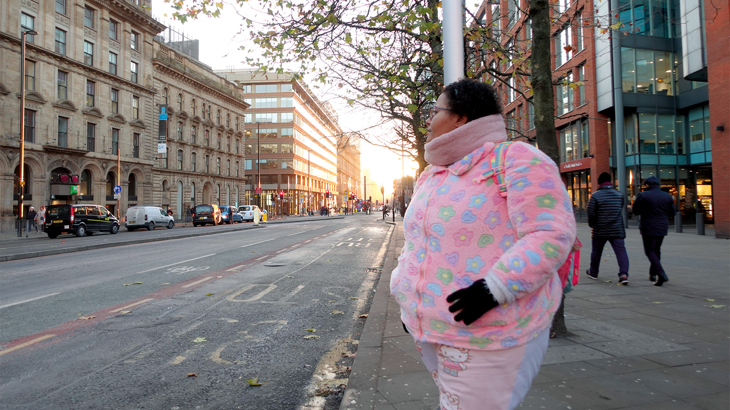79% of disabled people think a panel of disabled people that reviews walking and wheeling policy and holds government to account would help them walk or wheel more. Alisha told us about her experiences navigating around Manchester with autism, ADHD and severe anxiety. As a participant in our Disabled Citizens’ Inquiry, she explains how she often has to extend her journeys on foot due to a lack of designated crossing spots.
Watch Alisha's story.
“My autism, ADHD, anxiety and depression mean I really struggle in busy and dense city spaces.
“It’s intense for me to be surrounded by lots of people. It feels like they’re all walking directly towards me, and that everything is closing in around me.
“Because of my autism I also often experience a sensory overload from the noises around me and lights reflecting off shop windows.”
Navigating a busy city with an invisible disability
“In Manchester the backstreets are difficult to navigate because there’s not much signage.
“There also aren’t always designated crossing spots, so I end up making extended journeys, looking for safe places to cross.
“The pavements are narrow and bumpy, and this makes me feel like I should get on the road to escape people, whilst at the same time making sure I don’t fall over.
“It’s a challenge to make myself go out. It has to be something really compelling to make me go through an area which is going to panic me.
“There’s certainly a perception that autism is a childhood issue. Adults are often entirely ignored, unfortunately, which means we’re not involved in city planning.
“Attitudes are improving and I think empathetic people would help me if I was panicking. But I shouldn’t have to be panicking in the first place.
“The pedestrianised areas of the city are a real improvement. It makes it easier to move around as there’s more space and I know that I can safely stop for a short rest on the street furniture.”

Photo: Tom Hughes/Sustrans.
Lack of access to public transport close to home
Alisha prefers to travel by tram, but due to a lack of bus and tram stops near her home, she often has to pay for a taxi to then be able to travel via public transport. She explained:
“I massively struggle to travel by bus. I was struggling before the pandemic and it’s obviously gotten a lot worse since for me.
“It’s very hard if you want to get across the city via bus and it requires a lot of switching buses. I’d like to see increased bus routes and a variety of different routes.
“The nearest bus stop to me is a far walk away from my home and I find it hard to get on the bus, which compounds this.
“I find the tram easy to use as it’s very regimented, the stops are called out, you know exactly which route it’s taking and you don’t have to be thinking about all the maps in your head.
“Although, I can’t feasibly walk to my nearest tram stop as I live too far away, so if I want to get the tram I have to get a taxi.
“This adds on a lot of cost when I want to go out and makes it really hard for me to access going outside.
“It’s worrying when I think about how I’m going to get to medical appointments or go food shopping when I’m having to put aside a large amount of my monthly income for public transport, which isn’t even accessible for me.”





